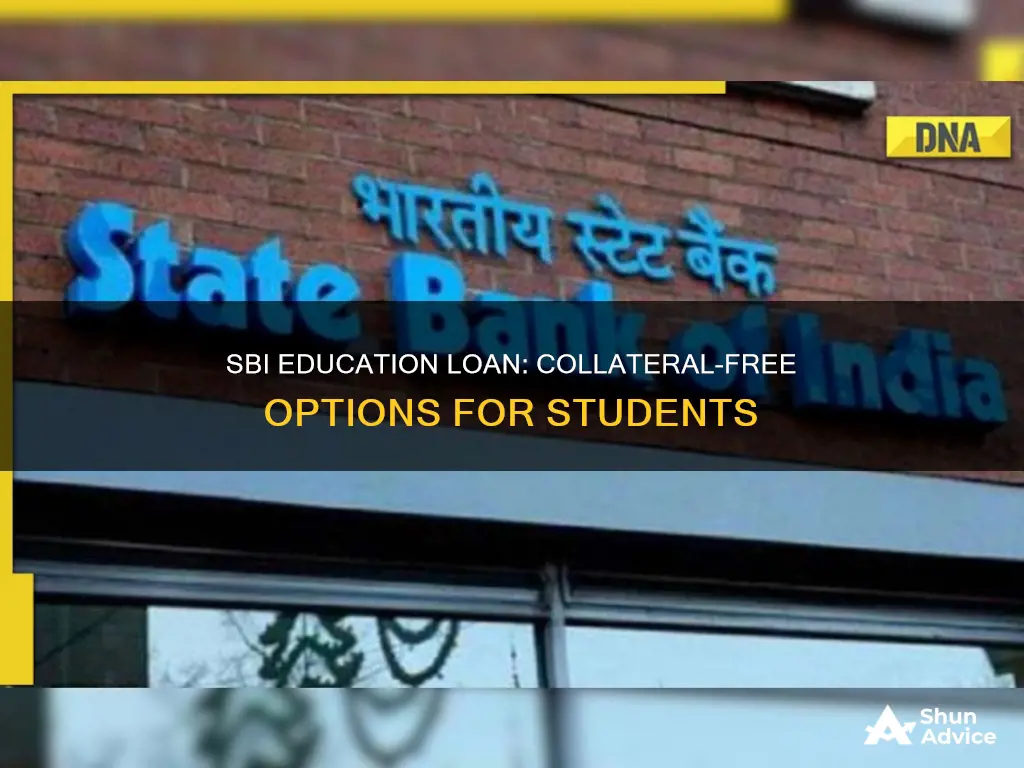
The State Bank of India (SBI) offers education loans to students aspiring to study overseas. SBI's Global Ed-Vantage scheme supports Indian students pursuing higher education in various countries, including the USA, UK, Canada, Australia, and Europe. The bank provides competitive rates and terms to ease the financial burden of studying abroad. SBI offers collateral-free education loans of up to INR 50 lakhs, with interest rates starting at 9.4% for female students and 9.9% for male students. For loans exceeding INR 50 lakhs, collateral is required, and the bank accepts various forms of collateral, including immovable property or liquid securities. SBI's education loan application process is simple and can be initiated online through their website.
| Characteristics | Values |
|---|---|
| Loan amount | Up to 50 lakhs INR without collateral; up to 3 crores INR with collateral |
| Interest rate | 9.9% for male students, 9.4% for female students, 10.15% |
| Co-applicant | Not required, but parents or guardians must co-sign the loan with the student |
| Loan procedure | Fill out the online application form on the SBI website |
| Documents required | Academic records, admission letter, financial statements, and other documents as requested by SBI |
| Processing fee | Fixed processing fee of ₹10,000; additional fee of ₹7,000 for legal opinion and property valuation |
| Margin | Up to 75% and 80% of the value of the property for a 2-year and 1-year course, respectively |
| Collateral accepted | Immovable property (excluding agricultural land), liquid security (e.g. fixed deposit, LIC policies, government bonds), third-party collateral |
| Countries/regions accepted | USA, UK, Canada, Australia, Singapore, Japan, Hong Kong, New Zealand, Europe |
What You'll Learn

SBI's Global Ed-Vantage scheme
The State Bank of India (SBI) offers education loans to students looking to pursue higher education in India or abroad. SBI's Global Ed-Vantage scheme is a loan tailored to Indian students aspiring to study overseas. The scheme offers loans of up to 3 Crore Indian Rupees (INR) to students pursuing full-time graduate, postgraduate, or doctorate courses at foreign universities. The loan covers tuition fees, travel expenses, and the cost of books, equipment, and other study-related expenses.
One of the key advantages of the Global Ed-Vantage scheme is that it does not require collateral for loans up to 50 lakhs INR. This makes it accessible to students who may not have valuable assets to pledge as security. SBI also offers concessions on interest rates for female candidates and a 0.5% discount for the Rinn Raksha Credit Life Insurance policy.
The interest rates for education loans without collateral typically range from 10.50% to 14%, and the loan amount sanctioned depends on the applicant's financial strength and their estimated repayment capacity after course completion. Students can apply for this loan with a co-applicant, and the bank will consider the future income and creditworthiness of both the applicant and the co-applicant.
To apply for the Global Ed-Vantage scheme, students can follow these steps:
- Review the loan information, including the moratorium period, repayment tenure, and interest rates.
- Visit the official SBI website.
- Fill out the application form and provide accurate and complete information.
- Scan and upload the necessary documents, such as academic records, admission letters, and financial statements.
- Submit the application form.
Santander Loans: What You Need to Know
You may want to see also

Interest rates and processing fees
SBI offers education loans without collateral up to a certain amount. The exact amount varies across sources, with figures of up to 7.5 lakhs, 50 lakhs, and even up to 100% funding mentioned. For loans exceeding 7.5 lakhs, collateral is required.
The interest rates for SBI's collateral-free education loans are competitive and slightly higher than loans with collateral. The interest rate for loans up to 50 lakhs for the top 100 universities is 10.50%. The interest rate for general courses starts at 8.50% per annum, while it starts at 8.20% for professional courses like MBBS, engineering, or management. SBI also offers a 0.5% discount on interest rates for female candidates and a 0.5% discount on the Rinn Raksha Credit Life Insurance policy.
SBI provides simple interest during the moratorium period, which does not complicate and reduces the future payment burden. The moratorium period is 6 months, which means students have a grace period of 6 months after completing the course before they need to start repaying the loan. The repayment tenure is 15 years.
SBI's unsecured education loans through GoStudyLoans have no processing fees, while other sources mention minimal processing fees. However, a small fee may be applicable depending on the applicant's profile.
SAP Warning: Impact on Subsidized and Unsubsidized Loans Explained
You may want to see also

Loan application process
The State Bank of India (SBI) does provide education loans without collateral, also known as unsecured education loans. The loan amount offered by SBI without collateral is up to 7.5 lakhs for loans in India and up to 50 lakhs for loans to study abroad.
- Eligibility: First, check your loan eligibility. The two main factors considered when providing an education loan without collateral are the future income of the co-borrower and borrower, along with their creditworthiness. The loan amount will depend on the applicant's and co-applicant's combined financial strength, the tenure of the course, and your estimated repayment capacity after course completion.
- Documents: You will need to gather the required documents, which may include marksheets and certificates (10th and 12th standard), proof of admission (acceptance letter from the college), standardized test scores (IELTS, GMAT, or GRE), bank account statements for the last 6 months, and Form 16 of the last 2 years. If the loan amount is above 7.5 lakhs, you will also need to provide collateral security, such as immovable property documents or liquid security.
- Application Form: Fill out the online application form carefully on the SBI education loan website or the Vidya Lakshmi platform. The details entered cannot be changed once the form is submitted.
- Processing: After submitting the application, the bank will review your application and get in touch with you for further steps. The processing time may vary, but you should receive a response within a certain period.
It is recommended to seek guidance from organizations like VidyaLoans or GyanDhan, which can assist you throughout the loan process and ensure a hassle-free experience. They can help you navigate the different loan options, eligibility criteria, and application procedures.
SAP's Loan Management: An Integrated Solution?
You may want to see also

Loan amount and collateral value
The loan amount and collateral value of an education loan from SBI are dependent on several factors. SBI offers education loans without collateral for up to INR 50 lakhs. This limit was previously INR 7.5 lakhs, but it was raised to INR 50 lakhs in 2024. For loans exceeding INR 50 lakhs, collateral is required. When applying for an SBI education loan without a co-applicant, a financial co-applicant is generally not necessary. Instead, students can choose a collateral-based loan with no financial co-applicant for amounts up to INR 50 lakhs.
The Global Ed-Vantage scheme offered by SBI is a specialised student loan for studying abroad. It provides loans of up to INR 3 crores to Indian students pursuing higher education in other countries. Under this scheme, collateral security provided by a third party (other than parents) may also be accepted. SBI gives up to 75% and 80% of the property's value for a 2-year and 1-year course, respectively. In the case of liquid security, borrowers can obtain up to 100% of the collateral value as the maximum loan amount.
The amount of the loan sanctioned will depend on the applicant's and co-applicant's combined financial strength, the course duration, and the estimated repayment capacity after course completion. The bank will consider the income or cash inflows, the strength or stability of the parent or guardian, the course of study, and the job prospects for loan repayment.
The interest rate for education loans without collateral typically ranges from 10.50% to 14%, with SBI offering rates starting at 10.15%. SBI also offers discounted interest rates for female candidates and a 0.5% discount for the Rinn Raksha Credit Life Insurance policy. It is worth noting that a processing fee may be charged for availing of an education loan without collateral, and this fee varies depending on the lender.
SAP and Unsubsidized Loans: What's the Connection?
You may want to see also

Alternative banks and NBFCs
SBI does provide education loans without collateral, up to Rs.7.5 lakhs. However, if you are looking for alternative banks and NBFCs that provide education loans without collateral, there are several options available in India.
Alternative Banks:
Private banks can offer collateral-free education loans of up to Rs. 40 lakhs, and up to Rs. 1 crore for studying abroad. Some popular private banks that provide education loans without collateral include ICICI, Karur Vysya Bank, Axis Bank, Avanse, and Auxilo. These banks have their own eligibility criteria, requirements, and loan terms, so it is essential to research and compare before applying.
NBFCs:
NBFCs (Non-Banking Financial Companies) also provide education loans without collateral, making education financing more accessible to students who may not have substantial assets. The loan amount offered by NBFCs can go up to Rs. 1.5 crores, and they usually base this amount on the student's choice of country, academic performance, course duration, and future earning potential. Some popular NBFCs that offer education loans without collateral include Propelld, Leap Finance, and Prodigy Finance.
When choosing an NBFC, it is important to select one that is registered with the Reserve Bank of India (RBI) and adheres to regulatory guidelines. Additionally, NBFCs often have streamlined loan application processes, requiring minimal documentation, which results in faster disbursement of funds.
Factors to Consider:
Regardless of the lender, there are several factors to consider when applying for an education loan without collateral. Firstly, the interest rates for such loans are typically higher because the lender does not have any security to safeguard their interest in case of repayment failure. Secondly, a processing fee may be levied, and this fee varies depending on the lender. Lastly, the eligibility criteria for these loans often include the academic performance of the student, the reputation of the institution, and the co-applicant's ability to repay the loan.
Application Process:
The application process for an education loan without collateral typically involves the following steps:
- Choose the most suitable overseas education loan that meets your specific needs.
- Review all the loan information, including the moratorium period, repayment tenure, interest rates, and any special provisions offered by the Indian government for studying abroad.
- Visit the official website of the selected lender.
- Fill out the application form on the lender's website, providing accurate and complete information.
- Scan and upload the necessary documents, such as academic records, admission letters, financial statements, and any other documents requested by the lender.
- Submit the application form.
It is always recommended to apply for a loan amount that covers your entire educational expense and to negotiate for the best deal in terms of loan amount, interest rate, and moratorium period.
SBI Education Loan: Eligibility, Interest, and More
You may want to see also
Frequently asked questions
Yes, SBI does offer education loans without collateral for up to 50 lakhs INR. For loans above 50 lakhs INR, collateral is required.
The interest rate for an SBI education loan without collateral starts from 9.4% for female students and 9.9% for male students.
To apply for an SBI education loan without collateral, you can follow these steps:
- Visit the SBI website and navigate to the education loan section.
- Fill out the SBI education loan application form.
- Provide the necessary documents, such as academic records, admission letters, and financial statements.







